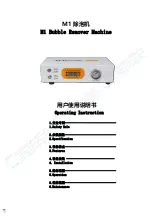
Coral Sea Vertical 6800
Page 2-9
Pre-installa
tion
SRC System.
13. Product water ultraviolet sterilizer destroys at
least 99.9% of any virus, bacteria and other
microorganisms which may pass through the SRC
R.O. Membrane Element. The optional U.V. sterilizer,
is highly recommended if the product water storage
tank, or cistern, is not otherwise treated by a means
such as chlorination. Use of the U.V. sterilizer is
also recommended if the system feed inlet is near
a polluted source such as a raw sewage outlet.
However, such polluted sources should always be
avoided.
14. Product water delivery pump (optional) fl ow control
switch activates the optional product water delivery
pump motor starter relay when potable product water
production is in progress.
15. Product water delivery pump pushes the potable
product water onward from the SRC R.O. System
to the product water storage tank or cistern. This
optional feature may or may not be necessary
depending on the location of the product water
storage tank, or cistern. Consult Sea Recovery’s
Application Engineering Department if the routing of
the product water line will cause pressure build up on
the product water line in excess of 20 psi (1.8 bar).
16. Potable product water outlet fl ange connection is
provided at the booster pump skid edge for fi nal
potable product water collection.
G. CLEANING & RINSING SUBSYSTEM:
Consists of supplied valves and required tank or container
for the cleaning, rinsing or storage of the R.O. System. The
System should be rinsed, stored, and cleaned from time to
time or as appropriate.
1. The fl ange connections at the booster pump skid
edge, cleaning tank skid edge and Controller skid
edge allow for interconnection of the cleaning tank.
2. Cleaning system drain valve used for draining the
cleaning tank.
3. Cleaning solution tank holds the rinse water, R.O.
membrane cleaning chemical or storage solution
during the appropriate operation.
4. Cleaning system pressure gauges allow the operator
to monitor the amount of R.O. membrane fouling and
subsequent cleaning effectiveness. The greater the
differential pressure observed at the onset of cleaning
indicates a greater amount of R.O. membrane
element fouling. The lower the differential pressure
observed at the end of the cleaning indicates the
success of the cleaning operation.
Vic connectors allow for simple connection of
cleaning chemical routing hoses into and out of the
R.O. membrane vessel assemblies.
Cleaning system fl ow restricter limits the fl ow or
velocity of the cleaning chemical to an effective fl ow
rate.
H. CHEMICAL PRE/POST TREATMENT SUBSYSTEM:
1. Chemical pretreatment tank (optional):
PRETREATMENT: Flocculent, Antiscalant, Sequestriant,
Sodium Bisulfi te, Chlorine, Others
POST TREATMENT: Chlorine, Bromine, pH neutralizing,
Hardness adjustment, Others
Flocculent pretreatment System is used in cases of
extreme turbidity of the feed water. If the feed water is
taken directly from the feed source, it may be necessary to
add chemical pretreatment to the System feed water prior
to the Media Filter. Flocculent chemicals coagulate the
suspended solids and assist the Media Filter in trapping
them. If the System feed water is taken from a well, other
natural fi lter bed, or if the feed source is extremely clear, it
will not be necessary to add fl occulent to the System feed
line.
Antiscalant or Sequestriant chemical protects the R.O.
membrane element from premature dissolved solids
fouling. Such chemical pretreatment will only be required
if the System is subjected to excessive recovery or if the
feed water chemical make up indicates that fouling would
occur. Normal sea water feed will not require antiscalant
or sequestriant pretreatment.
If the feed water has been treated with chlorine then it
must also be treated with sodium bisulfi te in order to
neutralize the chlorine as free chlorine will attack and
damage the R.O. membrane element.
Post treatment chlorine or bromine may be desired if
the product water will be stored in a cistern or tank for
extended periods or if biological intrusion is likely from the
cistern, tank or plumbing.
The product water from a R.O. System is aggressive and
slightly acidic. The product water, if not treated, will attack
metal piping systems. In order to neutralize the product
water pH neutralizing and hardness adjustment chemicals
are available.
2. Pump (optional), chemical metering
I. ELECTRONIC SUBSYSTEM:
This group of components includes the salinity controller,
optional soft motor starters, and optional power disconnect
switches. This subsystem measures water quality, controls
the direction of product water fl ow, and, contains the
central electrical connection point of the System. It also
serves as the safeguard ensuring only potable product
water is allowed to pass into the product water storage
tank.
Coral Sea Owner's Manual
Summary of Contents for Coral Sea
Page 3: ...SECTION 1 SYSTEM DESCRIPTION Coral Sea Owner s Manual...
Page 14: ...SECTION 2 PRE INSTALLATION NOTES Coral Sea Owner s Manual...
Page 25: ...SECTION 3 ELECTRICAL INFORMATION Coral Sea Owner s Manual...
Page 28: ...SECTION 4 INSTALLATION REQUIREMENTS Coral Sea Owner s Manual...
Page 35: ...SECTION 5 OPERATIONS MANUAL Coral Sea Owner s Manual...
Page 36: ...Operation THIS PAGE INTENTIONALLY LEFT BLANK Coral Sea Owner s Manual...
Page 166: ...Intentionally Left Blank Coral Sea Owner s Manual...
Page 167: ...SECTION 6 R O MEMBRANE INSTALL CARE Coral Sea Owner s Manual...
Page 193: ...SECTION 7 MAINTENANCE AND REPAIR Coral Sea Owner s Manual...
Page 194: ...Maintenance Coral Sea Owner s Manual...
Page 203: ...SECTION 8 COMPONENT USER MANUALS Coral Sea Owner s Manual...
Page 204: ...Page Intentionally Left Blank Coral Sea Owner s Manual...
Page 215: ...SECTION 9 DRAWING PULL OUTS Coral Sea Owner s Manual...
Page 216: ...Page Left Intentionally Blank Coral Sea Owner s Manual...
Page 247: ...SECTION 10 SPARE PARTS LIST Coral Sea Owner s Manual...
















































